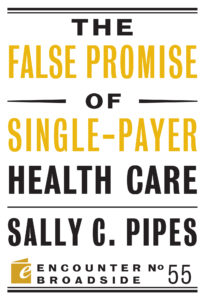Single-payer has failed abroad and at home. Yet the call for single-payer from progressives has never been louder.
Vermont senator Bernie Sanders (I-VT) and his dedicated followers have been the loudest. In his campaign for the Democratic presidential nomination in 2016, he promised “Medicare for All.” In September 2017, he and sixteen cosponsors—including four likely to seek the Democratic nomination for president—released a bill fleshing out some of the details of his plan. And on January 23, 2018, he held an online town hall meeting watched by over one million people to stump for single-payer.
The first thing to understand about Sanders’s Medicare for All plan is that it’s not simply an expanded version of the existing Medicare program. It’s much bigger. In fact, no country has a government-run health care system as all-encompassing and generous as the one Sanders proposes.
Medicare for All would cover everything from hospitalization and doctor visits to vision checkups and mental health care, free of charge.
Well, almost free—patients would be responsible for up to $250 out of pocket for prescription drugs.
There would be no provider lists, no need for referrals. Private insurance would be effectively outlawed; no insurer would be allowed to cover any of the benefits offered by Medicare.
The American people haven’t yet grasped what the Sanders plan would mean for them. Forty-seven percent think they’ll be able to keep their current insurance plans under single-payer.
The Sanders plan would upend the health care marketplace in just four years. In year one, anyone fifty-five or older as well as children up to age eighteen could sign up for Medicare. In years two and three, the age limit would drop to thirty-five. And in year four, everyone would be enrolled in the new program.
The American people haven’t yet grasped what the Sanders plan would mean for them. Forty-seven percent think they’ll be able to keep their current insurance plans under single-payer.
The Sanders plan is clear on what it will cover. It’s a lot less clear on how it will pay for it.
“Rather than give a detailed proposal . . . we’d rather give the American people options,” Sanders told the Washington Post in September 2017. “We have economists looking at it who are coming up with different numbers.”
Consider the plan Sanders proposed during the 2016 presidential campaign, which is similar to the bill he’s since introduced in the Senate.
The Sanders campaign claimed that Medicare for All would cost $14 trillion in its first ten years. The Urban Institute, a liberal think tank, calculated the cost at more than twice that—$32 trillion over ten years.
Even that estimate is probably low. History is littered with examples of government health care programs that have blown past their promised cost.
The administration of President Lyndon Johnson predicted in 1964 that Medicare would cost $12 billion in 1990; the actual cost was nine times that figure.
More recently, in 2010, the Congressional Budget Office pegged the cost of Obamacare at $940 billion over ten years. By 2017, the CBO had revised its ten-year projection of the program’s cost to about $2 trillion.
Sanders’s plans for coming up with the trillions he needs are similarly divorced from reality.
The Sanders plan is clear on what it will cover. It’s a lot less clear on how it will pay for it.
He has claimed that his bill would yield $6 trillion in savings over its first ten years, in part by paying health care providers less.
He also has posited administrative savings of $500 billion. Those savings will be difficult to realize, given that the total overhead tab for private insurers today is less than half that figure, according to the Centers for Medicare and Medicaid Services.
Sanders has said he could save another $113 billion a year by slashing drug prices. To do that, he would have to cut prices by one-third, since total spending on prescription drugs in 2015 was $325 billion. Cuts of that magnitude would devastate the industry’s ability to research and develop the next generation of cures—many of which could reduce long-term health costs.
To make up the rest, he’s floated a litany of new taxes, including a 7.5 percent payroll tax on employers and a 4 percent income tax “premium” to be paid by households. A top tax bracket of 52 percent, higher taxes on investment income, and a “wealth tax” on the net worth of the top 0.1 percent are also on the table.
Medicare for All might be the most brazen attempt at single-payer, and the most unrealistic.
Sanders has also assumed that the federal government would raise an additional $420 billion a year in revenue, as the tax-free compensation that workers once received in the form of health benefits would be subject to tax under his plan.
Medicare for All might be the most brazen attempt at single-payer, and the most unrealistic. But Sanders may also have set a marker that made a stealthier government takeover of our health care system seem downright reasonable by comparison.
Consider the perennial push for a “public option.” During the debate over Obamacare, many progressives argued for the creation of a government-run insurer to compete with private plans in the exchanges. The House’s version of what became Obamacare included the public option. The Senate’s, which eventually prevailed, did not.
A government-run insurer would have the capacity to absorb essentially limitless losses. So it could underprice private insurers and eventually drive them out of the market. The public option would soon be the only option.
That was the point. Yale professor Jacob Hacker, considered the inventor of the idea, said that the goal was to get to single-payer “in a way that we’re not going to frighten people into thinking that they’re going to lose their private insurance.”
None of these bills is likely to come up for a vote—much less become law—unless Democrats retake control of Congress and the White House.
In October 2017, the public option surfaced yet again. Democratic senators Tim Kaine and Michael Bennet dropped a bill that would, at first, allow people to buy into Medicare if they had only one choice of insurer—or no choices at all—through Obamacare’s insurance exchanges. Slowly but surely, their bill would expand eligibility—until 2023, when anyone would be allowed to buy into Medicare.
Democratic senator Brian Schatz offered his own take on the public option in 2017, proposing legislation that would allow anyone to buy into Medicaid. Conveniently, Schatz has left it to others to figure out how to pay for his bill.
None of these bills is likely to come up for a vote—much less become law—unless Democrats retake control of Congress and the White House. But they make clear to the American people what the Democrats will do if they take back the reins of power, and that completes the government takeover of the US health care system Obamacare started.
Encounter Books is an activity of Encounter for Culture and Education, a tax-exempt, non-profit corporation dedicated to strengthening the marketplace of ideas.

